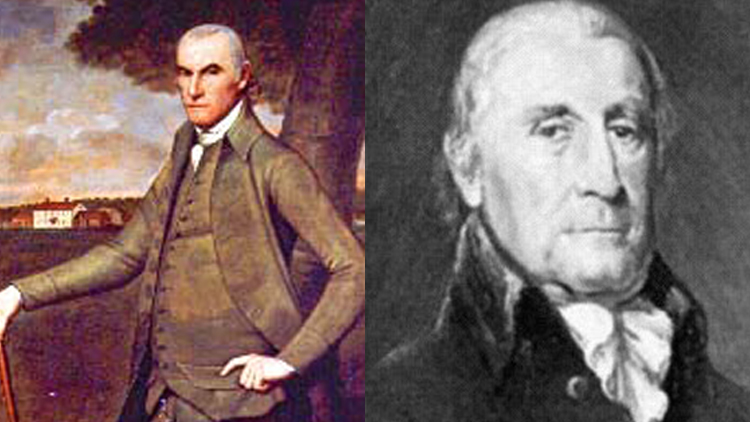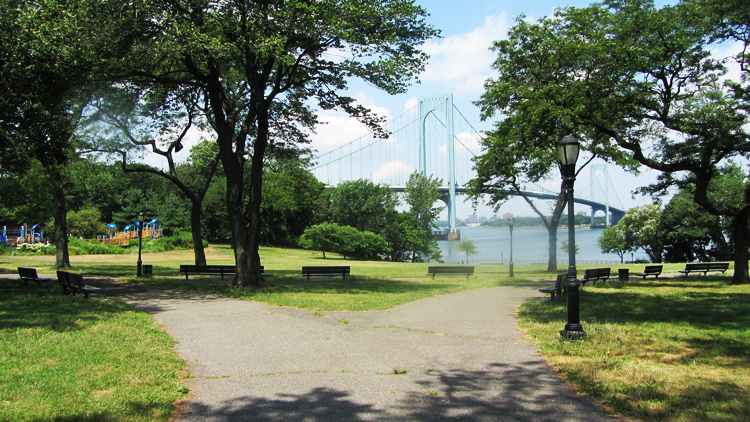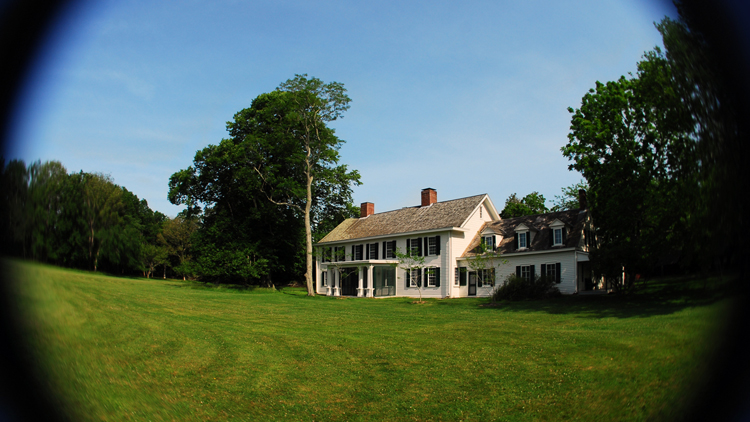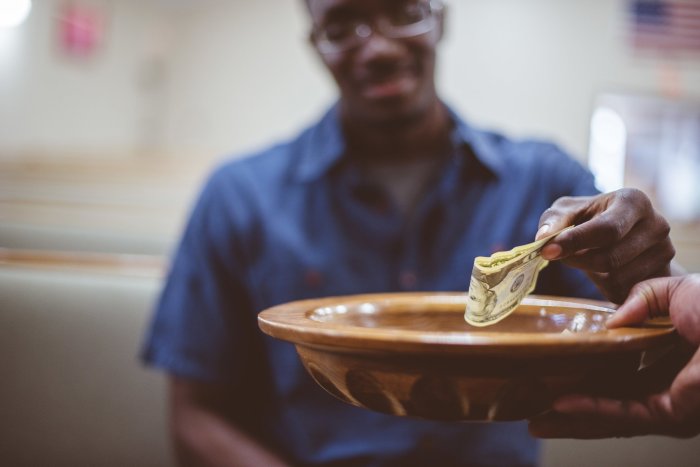To stand in the same room where Thomas Jefferson and James Madison and the Marquis de Lafayette once gathered is rare indeed, but to find such a place on Long Island—preserved in almost its original condition since the days of the Revolution—is unheard of. But such is the case for the estate of William Floyd, one of the signers of the Declaration of Independence, who made his home in Mastic.
“You don’t have to go to Virginia or Massachusetts to learn the history of our Founding Fathers—they were discussing the future of the country right here!” exclaims MaryLaura Lamont, a Park Ranger with the National Parks Service, who knows the William Floyd Estate inside and out.
New York had four signers of the Declaration, all living in the New York City area when the American Revolution broke out. But only Floyd’s property survived the war intact. The three other men weren’t so fortunate.
Lewis Morris resided in what was then Westchester County but would later become known as the Bronx. His manor was called Morrisania. After Washington lost the Battle of Long Island on Aug. 27, 1776, Morris and his family had to flee before the victorious British sacked his estate and destroyed his farm. Nothing remains of his former holdings today.
Philip Livingston, a wealthy merchant born in Albany, owned a townhouse on Duke Street in Manhattan and acquired a 40-acre estate in Brooklyn Heights by parlaying his profits from the French and Indian War (1754-1763). Gen. George Washington met there with his officers after suffering the worst defeat of the Revolutionary War and decided to evacuate all his troops from Brooklyn before the British could capture them. Subsequently, the British used Livingston’s Duke Street home as a military barracks and turned his Brooklyn Heights residence into a Royal Navy hospital. It burned down in 1811.
Of New York’s signers, Francis Lewis seems to have suffered the most.

Born in Wales in 1713, Lewis made his fortune in America as a merchant whose travels took him far and wide, from Russia to Africa. In 1756, he was at Fort Oswego, in upstate New York, where he was selling clothing goods to the British during the French and Indian War, when he was captured by the French commander, Gen. Montcalm. One story goes that he survived because his fluency in Welsh enabled him to understand what the Indians were saying so he could serve as a translator. Regardless, he was still shipped off to France in irons.
When the war was settled, Lewis returned to America with a gift of 4,400 acres from the British royal government in compensation for his years in French captivity. He quickly rebuilt his business and was in good enough financial shape to become a warden of St. George’s Church in Flushing from 1769 to 1772, which today has a plaque in his honor. By some historians’ reckoning, Lewis was one of the richest men who signed the Declaration. By the time the Revolution ended, he had lost most of his fortune but he had left his mark on history.
After the British had taken over Long Island, they went looking for him. As a local Queens historian, J. Carpenter Smith, wrote about Lewis in 1897: “A man of such influence and of such restless and daring activity could not be otherwise than obnoxious to the government. He was marked as a dangerous rebel.”
A group of royal dragoons rode up to his 200-acre Whitestone estate while a British warship pulled within range on the East River. Lewis was not home but his wife, Elizabeth Annesley, unfortunately was. As her servants were urging her to leave the premises, a cannon ball suddenly burst through the window and bounced at her feet, the story goes, but she wouldn’t budge, insisting that the artillery men couldn’t hit the same place twice. She was right about that but it did her no good.
A young British soldier tore the shiny buckles from her shoes. “All that glitters is not gold,” she reportedly told him, adding that the buckles were really just pinchbeck, a cheap copper alloy. Then the British ransacked the house, putting all Lewis’ books, papers and paintings in a pile and setting them on fire. Next they destroyed the house too and took Lewis’ wife, holding her in squalor on a prison ship without a bed or a change of clothing with the hope that her husband would come to her rescue so they could hang him.
The imprisonment took a toll on her health. When news of her ill treatment reached Gen. Washington in Pennsylvania, he ordered the arrest of the wife of the British paymaster-general and the wife of the British adjutant general, according to some historians, and threatened to subject them to the same abuse. The British agreed to a prisoner swap, so Elizabeth reunited with her husband in Philadelphia, but she was badly weakened. She managed to live long enough to see her son Morgan married but died in 1779 with her husband by her side. Lewis lived until 1802, and was buried in an unmarked grave on the north side of the churchyard of Trinity Church, where he had been a vestryman from 1784 to 1786. In 1947 the Descendants of the Signers of the Declaration of Independence erected a granite marker and a bronze plaque there in his honor.
Little known today was Lewis’ key role in thwarting what was known as the Conway Cabal. This was a plot by disgruntled American officers and members of the Continental Congress to replace Gen. Washington with Gen. Horatio Gates, the so-called “hero of Saratoga,” because he had defeated the British there. Lewis defended Washington’s command, ensuring that New York’s delegation stood firm, and the scheme died. And so the future of the country was ensured.
Today this signer of the Declaration has a high school in Queens named after him as well as a Masonic lodge. But the nicest spot is clearly Francis Lewis Park, which occupies the northern tip of Queens within the shadow of the Whitestone Bridge. Most historians reportedly believe Lewis’ home was once located on or near there because of the site’s proximity to the East River, although some have made the claim that his house was many blocks away. The place has a spectacular view of the river with a breeze blowing off the water even on a hot summer day, plus two bocce ball courts, an inviting playground complete with fountains for kids to play in, a fitness trail (eight loops to a mile), and a kayak and canoe launching area on the sandy beach at the bottom of a sloping grassy field.
All that remains to remind visitors about who the park’s namesake was is a plaque on a cracked granite pedestal erected in his honor by the Matinecock chapter of the Daughters of the American Revolution and “other Patriotic Citizens.” A tall white flagpole juts from it. Francis Lewis Boulevard, named for him in the 1930s, doesn’t reach the park, even though it’s more than 10 miles long. It starts in Rosedale and stops at the Cross Island Parkway. Some locals call the boulevard “Franny Lou.”

The Hero and the Heartbreaker
Lewis’ Suffolk County compatriot, Gen. William Floyd, was definitely the youngest and arguably the luckiest of New York’s signers. The British occupied his estate in 1776, ransacked his farm, took all his livestock and food stores, but they never torched the place. Thanks to the foresight of his heirs and the supervision of the National Park Service, the estate endures today as an historical gem. Visitors—who are regrettably few and far between—can stroll the grounds as Floyd’s family did and gaze upon the furnishings that were his—including his cradle and his desk, his “traveling medicine chest” (which held his liquor) and his Chippendale sofa.
An aura seems to pervade the site, giving credence to what one summer guest later described as “Magic…Mystic…Mastic.” Perhaps it’s the underlying continuity of the estate that makes it so special—and so alive. The Old Mastic House, as the Floyds called their home, changed over time as eight generations came and went, but the place never lost touch with the past. It was left fully furnished when it was formally taken over by the Park Service in 1976. One room may date to 1720, the one next to it might have been added in 1788, the formal dining room in the late 1890s, a kitchen in the 1920s, a dishwasher in the pantry in the 1960s. Over 250 years, what began as a six-room colonial house on a slave plantation grew into a 25-room summer home. A guided tour generally lasts an hour.
As Park Ranger MaryLaura Lamont explains, the William Floyd Estate is a “cultural preservation,” not an historical renovation, which makes its status rather unique in the National Park Service. The Floyds’ heirs have the right to be buried in their family cemetery in the woods, if they so choose.
“What you see here in this house is a combination of all the time periods,” says Lamont, who’s been working at this National Park Service site since 1979.
On July 4 and August 2, she’ll host a special program at 10:30 a.m. on William Floyd called “He Dared to Sign.” Other programs feature the site’s nature trails, the estate’s architectural history, a collection of old-fashioned toys plus the craftsmanship of carving hunting decoys. Recently, Lamont put on display the family’s extensive artwork, particularly the talented work of Katherine Floyd depicting the estate in the mid-19th century, which has never been shown in public before.
“I guess you could call it a continuum of change,” says Lamont. “It’s the history of America as you see it through the eyes of the Floyd family, so it’s a microcosm of American history.”
And to think that it all could have been irrevocably destroyed if the Federal Energy Commission had gone through with its initial decision to locate a nuclear power plant on the southern end of the property by Moriches Bay.
Cornelia Floyd Nichols, Gen. Floyd’s great, great granddaughter, heard about the project from her son-in-law David Weld, who was active in Suffolk County Republican circles. They had to act quickly, so they were able to get the 613 acres of forests, fields and marsh along with the original estate and all the outbuildings added to the new Fire Island National Seashore, which the National Park Service was establishing in 1965, rather than wait for Congressional approval to create a separate entity for the Mastic manor.
The estate’s entrance is only a little more than two miles from the William Floyd Parkway, off Neighborhood Road (aka Havenwood Drive), but it might as well be a million miles away because it seems so remotely removed from our time and place.
“They loved it here,” says Lamont. “And that’s why they wanted it preserved.”
Before the Revolution started, William Floyd had been a trustee of the town of Brookhaven and a colonel in the Suffolk militia. A prominent citizen, Floyd was chosen to represent New York in the First Continental Congress of 1774, and the second one a year later. Through his sisters’ husbands, Gen. Nathaniel Woodhull and Ezra L’Hommedieu, Floyd had ties to both the Culper Spy Ring and the largest slave plantation north of the Mason Dixon line, the Sylvester Manor on Shelter Island.
According to historian Alexander Rose, whose book about the spy ring was the basis for the AMC series, Turn, Abraham Woodhull became a spy for Washington to avenge the mistreatment of his kinsman, Gen. Woodhull, who had died of gangrene while being held on a prison ship in the East River following his capture in the Battle of Long Island.
Ezra L’Hommedieu was the great-grandson of Nathaniel Sylvester, the estate’s first owners.
William Floyd could also be blamed for causing James Madison heartache. It was his 15-year-old daughter Kitty who captured Madison’s eye. He was 30 at the time but they got engaged. When she turned 16, Kitty wrote the future fourth president of the United States a letter breaking off their courtship because she was marrying another guy. Madison literally blotted out every reference to her in his diary. It took him 10 years before he found Dolly, who became his first lady. And the rest is history.

Happy Birthday, America
As generations of Americans first learned in school, Thomas Jefferson deserves the credit for drafting the Declaration, the first document to define the country that we would become. Not known for his public oratory—John Adams once remarked that “during the whole time I sat with him in Congress, I never heard him utter three sentences together”—Jefferson had already earned a reputation for wielding a “masterly pen,” and writing, as Adams put it, with a “peculiar felicity of expression.” The results of his penmanship—helped along with some useful edits and some key deletions, such as the end of slavery, and no mention of women’s suffrage—has stood the test of time, and inspired millions ever since.
Officially the Declaration is celebrated on July 4th, but contrary to tradition, no one actually signed it until weeks afterwards. Indeed, New York’s foursome didn’t begin to add their signatures until August 2.
Those who signed their names knew they were committing high treason, punishable by death. And it’s that willingness to make the ultimate sacrifice for a cause they believed in—with slim hope that they would ever prevail against the mightiest empire in the world at that time—that continues to inspire their descendants today.
“Francis Lewis wasn’t a military man—he was just a businessman,” explains Christian Ford, an attorney in Virginia who recently learned that he’s a descendant of Lewis. “So what made him decide that ‘I’m going to sign, I’m going to essentially commit treason and band together with these other men and form a republic—and I’m going to risk my life, my family and my wealth to do that?’ What made Francis Lewis make that commitment over other men similarly situated who decided they were going to take a safer route?”
That curiosity resonates with another descendant of Francis Lewis, Kathy Coley, who lives in Port Washington and works in the communications department of Farmingdale State College.
“It makes me proud that a family member had that level of conviction,” she tells the Press.
And remembering their sacrifice makes every Fourth of July a little more special.
For more information on the William Floyd Estate, which is administered by Fire Island National Seashore, call 631-399-2030; or go to nps.gov/fiis/planyourvisit/williamfloydestate.htm.The Old Mastic House is open for free guided tours every Friday, Saturday and Sunday, plus holidays from Memorial Day to mid-November.
For information about Francis Lewis Park, go to nycgovparks.org/parks/Q126. The park, which is run by the New York City Parks and Recreation Department, is on 3rd Avenue between Parsons Boulevard and 147th Street.

































